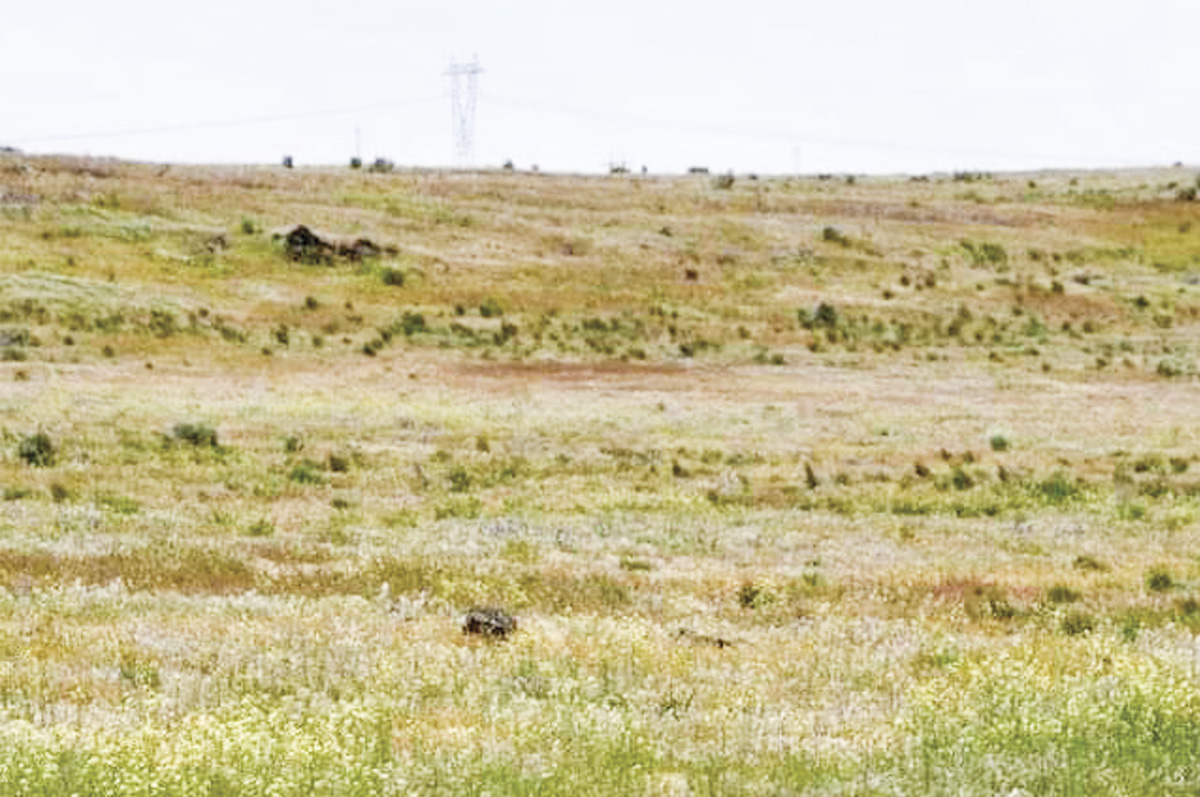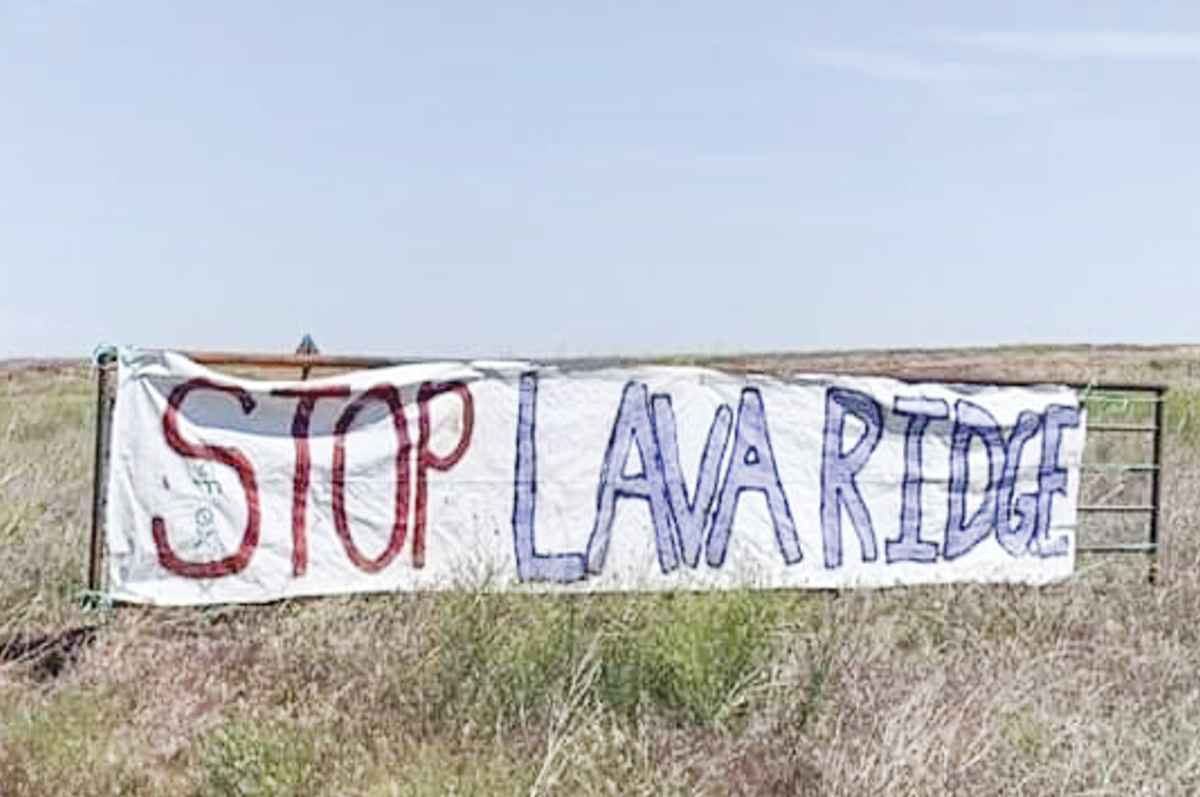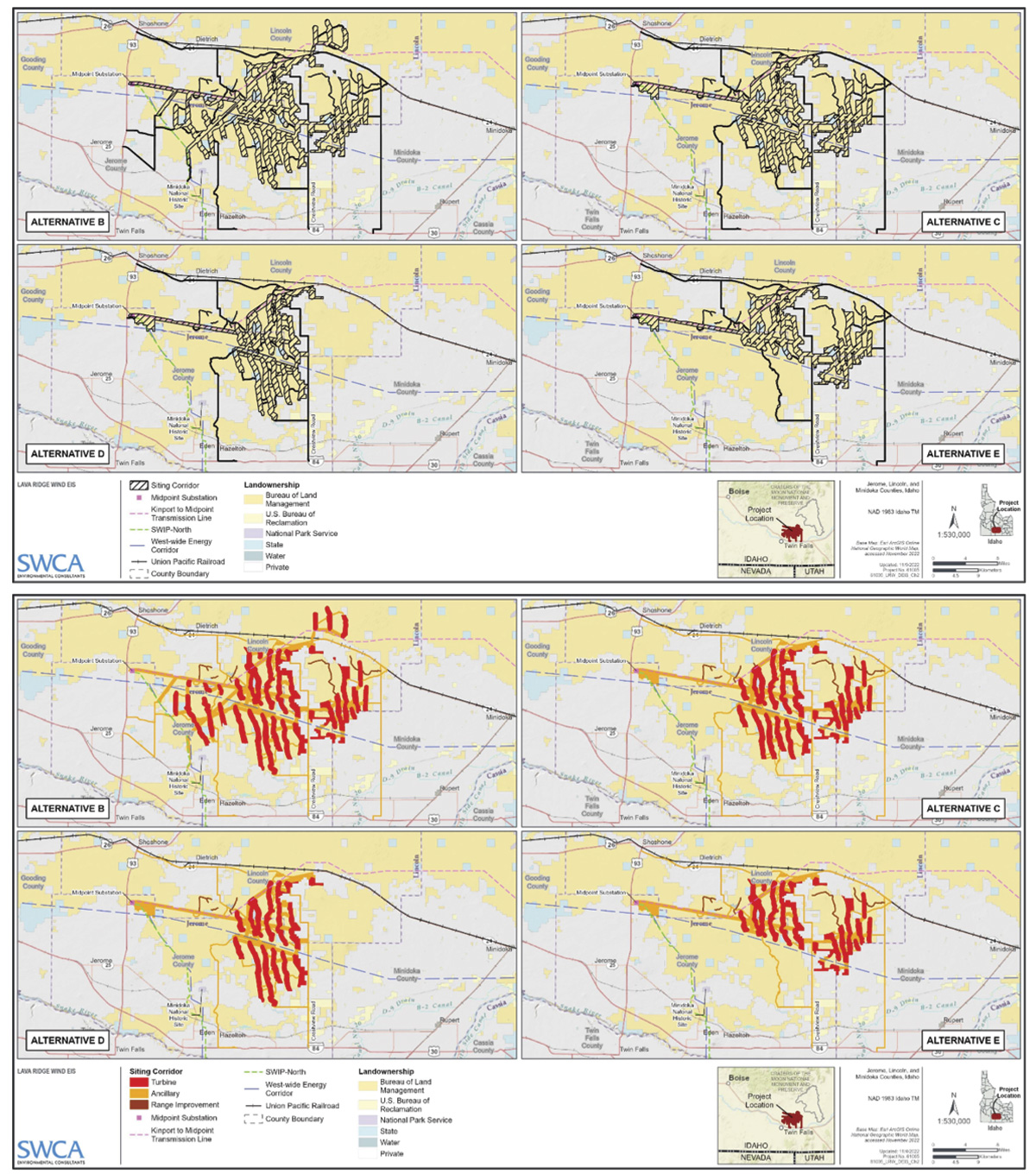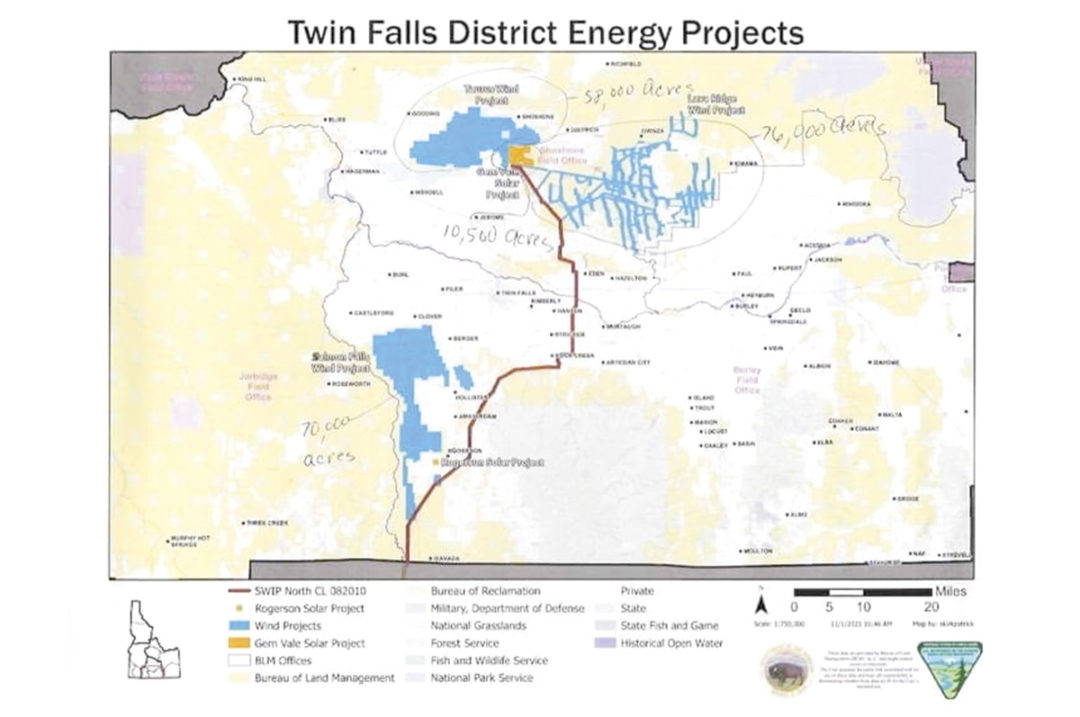The proposed Lava Ridge Wind Project is a commercial-scale wind energy facility and would consist of up to 400 wind turbines and associated infrastructure, including new and improved roads, powerlines for collection and transmission of electricity, substations, operation and maintenance facilities, and a battery storage facility. The project would be located about 25 miles northeast of Twin Falls, mainly on public land in Jerome, Lincoln and Minidoka counties. It does impact the Minidoka National Historic Site. With approval, final permitting, design and construction should begin in 2023, with operations in 2025.
The Lava Ridge proposed allotments include approximately 140,000 acres of land under management of the Bureau of Land Management (BLM). Construction will disturb approximately 5% of the land (about 7,300 acres). After construction, 5,500 acres of land will be rehabilitated, leaving 1% of the land (1,800 acres) occupied by project infrastructure during operations. The area will not be closed off to hunters, recreationists or ranchers.
Issues facing current land users
The Lava Ridge and Salmon Falls project areas have been used for livestock grazing for over 100 years, and the majority of the two projects occur on land used for livestock grazing. “During the Lava Ridge field trip, the BLM said 42 ranches would be affected,” says Diana Nielson, who raised cattle and horses and is an advocate against the Lava Ridge Wind Project. She also has an ag econ degree and is a member of a Facebook group called Stop Lava Ridge. “They have 60,000 animal unit months [AUMs] in the three grazing associations: Star Lake, Sid Butte and Milner. The graziers are in limbo. Magic Valley Energy (MVE) requested the graziers to draw up a mitigation plan. The graziers did and it was rejected.
“Cattle that graze on the range need to know where the water is and how to fend for themselves. Calves learn from the mother cows who learned from their mothers. To take your cattle off the range for a couple years will be very difficult to acclimate the replacement cattle to the high desert plain vistas. AUMs will be lost that will cause economic loss,” says Nielson.
She says, “Grazing cattle also decreases wildfire fuels,” which would be another reason to not suspend grazing during a construction period. Some areas may have access temporarily restricted during certain portions of construction due to safety measures, which will last around two or more years. “The disturbed land with native plants will be susceptible to invasive weedy plants and grasses. These plants will increase fuels for wildfires.”

In addition, “The water trough pipelines will be cut during wind turbine construction,” says Nielson. “Wildlife depend on this water too. Fences will be taken out. The replacement fences will be conformed for the wind turbines, not for rotating grazing allotments.
“The graziers can’t accept the poor mitigation plan they have been offered,” Nielson says. “If they mitigate, they have already lost. Mitigation or litigation, either way they lose economically. The ranchers and farmers are faceless with no acknowledgement of their value to the investment corporations.”
According to MVE, the rehabilitation and mitigation program implemented during and after construction seeks to maintain or improve grazing operations. Examples of mitigation include: phased construction, reseeding, weed control, fire suppression, improved fences and improved water facilities.
Nielson says since “they haven’t picked a site for the wind turbines, the graziers' destiny for keeping their grazing and water rights are in limbo. The psychological impact of this situation is very depressing. The Star Lake has the most to lose with 30 percent. As I read the draft EIS [environmental impact statement], I wonder why the association wasn’t allowed to replant sagebrush after several fires?”
A Dietrich rancher “lost around 700 head awhile back from a wildfire on his BLM allotments. Graziers have been under attack and have been losing AUMs for quite awhile for sage grouse, pygmy rabbits and plant species, yet this [new project] is being allowed,” Nielson says. “I have multiple concerns. Especially with ‘unsafe zones around each turbine.’ This affects grazing, public access, dispersed camping, wildlife … buildings, transmission lines and large battery storage.”

The other side
“As we strive to be a good steward of the land and good neighbor to the community and Magic Valley ranchers, MVE has hired Jack Alexander, a certified rangeland consultant from Synergy Resource Solutions, to work closely with the AUM holders to understand their operations and develop the right plans to ensure ranching legacies are protected and upheld,” says Luke Papez, senior director of project development for Magic Valley Energy.
He says, “A general absence of environmental resources of concern is also critical to siting energy projects. The Lava Ridge and Salmon Falls project areas are not in their native state due to fires, past land use and previously disturbed habitat. MVE’s projects are also outside of prime sage grouse habitats, which precludes these projects in many other areas of Idaho and Nevada.”
Project organizers admit it is unlikely the project sites will return to their native state, with or without MVE’s projects. The vast majority of the Lava Ridge project area has experienced fire damage. Much of the area has been invaded post-fire by annual grasses (cheatgrass) and/or was reseeded to crested wheatgrass. Even with cost-prohibitive restoration efforts, current technology does not provide a way to restore these rangelands to native conditions.
Rehabilitation of the areas disturbed by the project will focus on improving the current conditions and increasing ecological functionality and resilience, which will positively enhance the livestock ranching grazing areas.
The power the project will produce has not been sold yet, but there is significant interest in Idaho and in surrounding states for the power from Lava Ridge.
One of several
A second MVE wind project proposed in Twin Falls County (called the Salmon Falls Wind Project) proposed allotments include approximately 128,000 acres of BLM land. Construction will disturb approximately 6% of the land (about 7,300 acres). After construction, 4,500 acres of land will be rehabilitated, leaving 1% of the land (1,500 acres) occupied by project infrastructure during operations. This project timetable is a few years behind Lava Ridge – the BLM hasn't started the environmental impact statement process yet, so it's at its very beginning stage.
Shoshone Wind Energy Right Of Way is a 58,380-acre pending wind energy zone between Gooding and Shoshone owned by Taurus Wind LLC.
Jackpot Solar
Jackpot Solar is Duke Energy’s first renewable energy facility in the state, and it will be the largest solar facility in operation once completed.
“The Jackpot Solar project was developed on private land and is leased from a single landowner, who made the decision to be a part of this project,” says Valerie Patterson, communications manager for Duke Energy. “The landowner manages the ranching operations, and the project utilizes approximately 950 acres.”
The landowner is J.R. Simplot Company. “It’s an additional source of income – a dry deeded-land asset near a major transmission line,” said Tom Basabe, President L&L Group at J.R. Simplot Company.
“In terms of project benefits, the project is expected to pay over $30 million in property taxes and direct payments to landowners over the project life, injecting money into the local economy,” says Patterson. “It was also selected as an economic resource by Idaho Power and will provide clean energy, while lowering energy prices across Idaho Power’s territory.
“The solar project offers an opportunity for the landowner to receive a new, diverse revenue stream from their land. Ranching is expected to continue on the landowner’s land outside of the solar operations area,” says Patterson.
She says, “At the end of the solar operations, the solar facility will be removed within 180 days of termination of the project, and the land will be seeded to return to a state similar to how it was prior to construction.”
Jackpot-Franklin Solar Facility is a 100-megawatt (MW) solar photovoltaic (PV) power project. A pair of solar facilities is being developed in Twin Falls County. Franklin Solar Project will utilize 2,533 acres, which is adjacent to the Jackpot Solar project. Public hearings were held early in February. It originally was expected to operate in December 2023.
“Details and conditions for Franklin are still under negotiation, so we’re unable to share much about that project at this time,” Patterson says.

Update since originally posted
In a press release dated Feb. 6, 2023, on U.S. Sen. Jim Risch’s website, it says: U.S. Sens. Jim Risch and Mike Crapo, Gov. Brad Little, Lt. Gov. Scott Bedke and Congressman Mike Simpson jointly communicated deep concerns to Idaho’s head of the federal BLM about the Lava Ridge wind farm proposed in south-central Idaho.
In a letter to Karen Kelleher, Idaho state director for the BLM, the Idaho elected officials reiterated the lack of community support for the project.
“Idahoans cherish the concept of multiple and mixed uses on their public lands. This requires conservation, predictability of use and, most importantly, support from the local communities. These deep-rooted values are compromised by a piecemeal approach to large-scale generation projects on public lands. Dedicating hundreds of square miles of public lands to a specific use will have a long-term effect on recreation, grazing, sporting uses and the land in general,” they said.
The Lava Ridge project is a massive wind energy project proposed for development on BLM land in southern Idaho. Last month, the BLM proposed two preferred alternatives as part of its draft environmental impact statement. The public comment period is open until March 21, 2023, and Idahoans can obtain more information here.
“Affected farmers, ranchers, tribes, the Japanese-American community and sportsmen have voiced legitimate objections. As it stands today, the local community predominantly has not shown support for this development,” they continued.
The Idaho leaders also pointed to concerns that the project compromises fire suppression and sage grouse habitat and potentially could impact existing electricity customers and the integrated resource plans of Idaho utilities. They said project construction could damage transportation infrastructure and may impact the availability of labor and construction materials for other projects in the area.
“We urge the BLM to reassess and refocus the process on working with the local communities to address the concerns outlined above,” they wrote. “If all of these concerns are not addressed, it is unlikely we will be able to support this project moving forward.”
Read the full letter from Little, Bedke, Crapo, Risch and Simpson here.



.jpg?t=1687979285&width=640)

.jpg?height=auto&t=1713304395&width=285)


